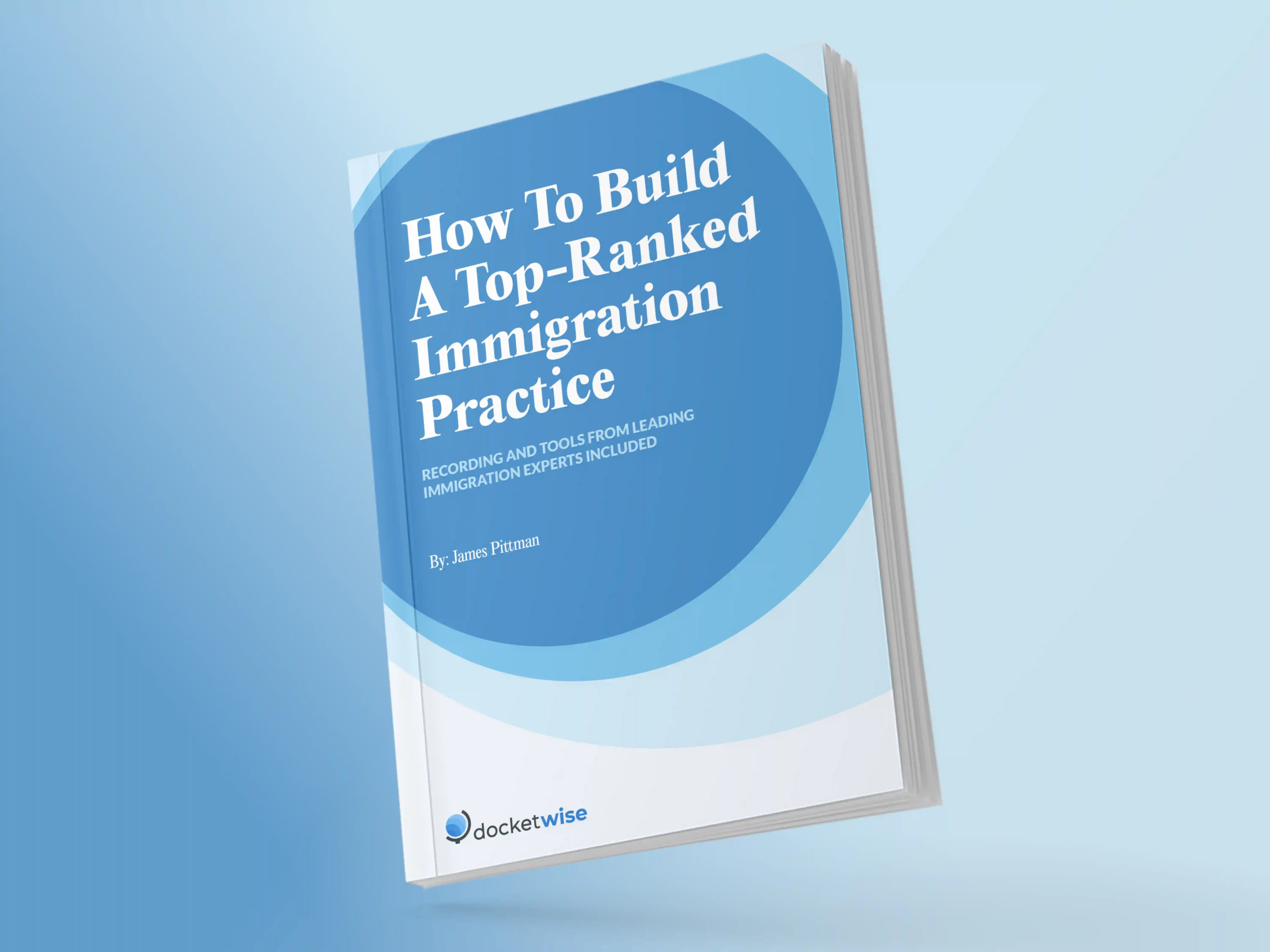Key takeaways
The PERM process involves several steps, including obtaining a Prevailing Wage Determination, following specific recruiting procedures, and submitting a PERM application.
In total, the PERM process can take 22 to 36 months.
Higher workloads and funding shortfalls contribute to extended PERM processing times.
The Permanent Labor Certification (PERM) is an essential component of the U.S. employment-based immigration process. It requires employers to demonstrate that there are no qualified U.S. workers for a specific position, a prerequisite to hiring a foreign worker. As a business immigration lawyer, you will manage the PERM process for your employer clients.
To support your business clients in this area, you must know how PERM works and understand the current application processing times. With this knowledge, you can set realistic expectations so clients can plan their hiring process accordingly or explore alternative immigration options if necessary.
This guide covers PERM and Green Card processing times, plus strategies for managing PERM delays.
What is PERM labor certification in immigration?
PERM, or Program Electronic Review Management, is a Department of Labor (DOL) process for an employer seeking to sponsor a foreign worker to prove there are no qualified U.S. candidates available for the job. PERM is the first step in obtaining a Green Card or an employment-based immigrant visa. PERM’s objective is to ensure that hiring foreign workers does not adversely affect the U.S. labor market.
The steps of the PERM Process are as follows.
Prevailing wage request filing: The employer files a prevailing wage request with the DOL through its FLAG (Foreign Labor Application Gateway) website by completing Form ETA-9141. Note that this form is also used to request PWDs associated with other immigration-related employment processes besides PERM, including CW-1, H-1B, and H-2B.
Prevailing Wage Determination (PWD): The DOL produces a PWD in response to the prevailing wage request filing. The PWD establishes the appropriate wage for the job based on the geographical location and required experience level of the job.
Recruitment process: Under PERM regulations, the employer must conduct a thorough recruitment process. This involves posting advertisements with the state workforce agency for 30 days and placing ads in a major regional newspaper on two different Sundays. Additionally, the employer must engage in three other recruitment activities from a specified list of choices, such as participating in job fairs or placing advertisements on TV or radio.
Notice posting requirement: Besides the recruitment activities, the employer is required to display a job notice at the worksite for ten consecutive days. This “notice of filing” must be clearly visible to employees, posted for at least ten consecutive business days between 30 and 180 days before the PERM application is filed, and retained in the employer’s audit file as proof of compliance.
ETA-9089 filing: If the recruitment efforts reveal no qualified U.S. workers are available, the employer files the PERM application, Form ETA-9089, online via FLAG. This form documents the job details, recruitment steps, and the foreign worker’s qualifications. Successfully navigating these steps ensures compliance with U.S. labor laws while allowing the employer to hire a skilled foreign worker.
PERM processing timelines in 2025
To address the common question: How long does PERM take? Here is an overview of each step and the current estimated processing times.

Prevailing wage determination
Processing timeline: Five months to eight months (flag.dol.gov)
The Prevailing Wage Determination timeline is about five to eight months. The DOL is reviewing PERM PWD applications submitted in April 2025, but there are still outstanding applications dating back to November 2024. Longer processing times are associated with reconsideration requests and cases that require further review by DOL expert analysts.
A reconsideration request is a formal appeal of a PWD. The DOL responds to these requests with a center director review. Currently, the DOL is processing center director reviews submitted in June 2024.
The steps to request a PWD are:
Gather required information: The request form requires job title, description, requirements, and work location.
Complete Form ETA-9141: Accurately fill out all sections of the form.
Submit Form ETA-9141: Form ETA-9141 can be filed electronically via FLAG or by using legal immigration software like 8am™ DocketWise.
Monitor ETA-9141 processing time: As noted, the prevailing wage determination timeline can extend to eight months. In this period, you will want to track the Form ETA-9141 status and any updates from the DOL.
Recruitment efforts
Timeline: 60 days to 180 days, or two months to six months (nolo.com)
The recruitment process involves multiple job advertisements to ensure no available U.S. workers are qualified for the role:
Place a job order with the state workforce agency: The job order must be live for 30 consecutive calendar days. Employers cannot file a PERM application until 30 days after the job order expires.
Publish two Sunday newspaper advertisements: The ads must include the employer’s name, application instructions, and a job description that includes the work location.
Post a notice at the employer’s location for 10 consecutive business days. The notice should describe the job and inform current employees that the employer is pursuing a foreign worker certification.
Take three additional recruitment steps. The employer must also advertise the job in three of the 10 approved locations. Options include an ad on the company website, promotion at a job fair, radio or television ads, and on-campus recruiting at a nearby college.
Your client must attempt to interview all job candidates who apply during the recruitment phase. Detailed notes on outreach and interviews for all applicants may be useful if the PERM application is later selected for audit. Employers must document disqualification reasons for all interviewed applicants.
Your client can proceed with filing a PERM application once all recruitment steps are complete and at least 30 days have passed since the last recruitment step closed, but no later than 180 days after the earliest recruitment step began.
Form ETA-9089 processing time
Processing timeline: 483 days, or 15 months to 16 months (flag.dol.gov)
The ETA-9089 processing time can be up to 16 months. The DOL division responsible for PERM applications is the OFLC, or Office of Foreign Labor Certification. The OFLC is reviewing PERM applications submitted in May 2024 and reconsideration requests submitted in June 2025.
Form ETA-9089 is the PERM application. The form collects information on the employer, prevailing wage, job duties and requirements, salary, recruitment process, and the foreign worker. You can complete this lengthy form manually for your client or by using the autocompletion capabilities of DocketWise.
The potential outcomes of an ETA-9089 filing are:
Approval: Your client can proceed to the Green Card process after approval.
PERM audit: If the OFLC chooses to audit the PERM application, you must submit additional documentation. An audit can significantly extend the processing time.
Denial: A denial may be issued if the application is incomplete or if the audit documentation is not provided satisfactorily.
Given the extended processing timeline, a robust PERM tracking system is recommended for lawyers.
PERM audit
Processing timeline: Up to six months (Jeelani-law.com)
During an audit, the OFLC requests additional documentation to support the PERM application. According to immigration advisory firm Newland Chase, the most requested documentation includes:
Proof of recruitment ads
Copies of resumes and applications received during the recruitment phase
Documentation of the employer’s recruitment process
Legal reasons why U.S. applicants were disqualified for the job
Newland Chase recommends responding to the audit notice with the requested evidence and a thoughtfully composed letter that outlines the evidence of compliance with PERM regulations.
How long does PERM take in total? Adding up the estimated timelines for each step, the entire process can take 22 months to 36 months.
Factors affecting processing times
PERM application processing currently extends beyond a year, and the timelines may only get longer. Factors include:
Increasing workload: Between May and July 2025, 13,886 PERM applications were filed monthly on average, implying more than 166,000 applications annually. In 2023, OFLC received approximately 159,000 PERM applications, a record number. This trend aligns with other immigration statistics, indicating an ongoing rise in cases.
Funding shortfalls: The DOL has been plagued by funding shortfalls recently. These funding issues have directly extended processing times for PERM applications, according to law firm Holland & Hart. President Donald Trump’s fiscal 2026 DOL budget proposal recommends cutting at least another $3.6 billion from the department’s budget. If the proposal is approved, PERM processing delays may increase.
Next steps to Green Card
Following PERM application approval, your client must file Form I-140 with U.S. Citizenship and Immigration Services (USCIS). The form must have the appropriate category selected and be submitted with supporting evidence and a filing fee.
After the I-140 is approved, you can proceed with the necessary steps to obtain a Green Card for your client’s job applicant. Those steps are outlined below.
Monitor priority dates and Visa Bulletins: You must monitor the applicant’s priority date. Once it becomes current, it’s time to file Form I-485 or proceed with consular processing. You can track priority dates with the Visa Bulletin from the U.S. Department of State.
For applicants in the U.S., Form I-485 (Adjustment of Status): If the applicant is in the U.S., filing Form I-485 requests a status change to lawful permanent resident. The I-485 application typically requires a background check, a biometrics appointment, and an interview with USCIS.
For applicants outside the U.S., consular processing: Consular processing is required when the worker is outside the U.S. This involves submitting the applicant’s documentation to the National Visa Center (NVC). Applicants must interview at a U.S. consulate or embassy in their home country. The timing for consular processing varies based on the specific consulate's workload.
For dependent family members in the U.S., work authorization request: A dependent spouse or child of an I-140 beneficiary can file for an Employment Authorization Document (EAD). This allows for legal work in the U.S. while waiting for the Green Card process to complete.
Maintain non-immigrant status: Applicants must maintain their current visa status while awaiting their Green Card. This may involve applying for visa extensions.
Green Card processing times
The processing times for Green Cards can vary widely based on several factors, including the category of the visa, the applicant's country of origin, and the workload of USCIS or the consular office. Here’s an overview of Green Card statistics:
EB-2 and EB-3 visas: These employment-based visas generally take 24 to 30 months to process (travel.state.gov). The EB-2 visa is for individuals with advanced degrees or exceptional abilities, while the EB-3 visa is for skilled workers, professionals, and other workers.
I-140 processing: The standard Form I-140 processing timeline is six to 18 months. Premium processing that shortens this timeline to 45 calendar days is available for an additional fee (manifestlaw.com). Premium processing expedites processing only, but it may not speed up the overall Green Card issuance.
Adjustment of status (I-485): The adjustment of status process currently takes less than a year. Most (80%) of cases are completed within 10 months (egov.uscis.gov), but the timeline can vary based on case specifics and USCIS workload.
Consular processing: Consular processing times for applicants outside the U.S. range from a few weeks to nearly 10 months (travel.state.gov).
H2: Strategies to navigate PERM delays
Knowing how to navigate PERM delays helps you manage client expectations and achieve successful and timely case outcomes. The most helpful strategies streamline your processes for collecting and organizing documentation, completing and filing forms, tracking immigration case deadlines, and collaborating with your team.
H3: Maintain meticulous documentation
Meticulous documentation of PERM cases is essential. If the case is flagged for an audit, having thorough documentation can make the difference between an approval and a denial.
One goal of the PERM audit is to enforce a fair and complete U.S. recruitment process. To prove compliance with PERM recruitment requirements, you must provide your client’s job advertisements, resumes, and applications submitted for the role, documentation of the client’s attempts to schedule interviews, interview notes, and valid disqualification reasons for all U.S. applicants.
Piecing this information together after the fact is time-consuming and error-prone. It’s far better to work with your client proactively to build the documentation as recruitment activities happen.
Streamline with e-filing of ETA-9141
You can e-file ETA-9141 in FLAG, but you can create added efficiencies by using legal immigration software instead. DocketWise supports ETA-9141 e-filing, so you can submit these forms directly from the application you work in daily. The software automatically logs the filing date and time for easy reference later. DocketWise e-filing saves time, reduces errors, and allows you to track multiple client filings efficiently.
Use smart forms for ETA-9089
DocketWise Smart Forms collect data at intake, which is used to auto-populate immigration forms, including ETA-9089, with optional appendices and final determination. The forms additionally have built-in compliance checks with verification prompts. Automatic form completion from stored data, plus compliance checks, helps minimize denials and reduce your audit risk.
Automate PERM workflows
Automated workflows support enhanced PERM tracking and keep cases moving forward. DocketWise supports custom workflows by matter type and case status, so you can organize your team’s PERM process in detail, with actions, tasks, or reminders triggered by dates and case status changes. These automations can deliver efficiencies by enhancing collaboration, tracking deadlines, and keeping your team on task.
Manage PERM workflows with DocketWise
The PERM process can take several years from start to finish. Staying organized across multiple clients is a primary challenge for business immigration lawyers. DocketWise can help with its comprehensive suite of case management capabilities.
DocketWise ETA-9141 e-filing capability and Smart Forms, which quickly produce accurate ETA-9089 Forms, further accelerate processes. Business immigration clients, in turn, recognize the value of a transparent, organized process that proactively addresses audit risk.
Book a demo today to experience the power of DocketWise and learn how it can help your firm.
Unlock Your Success as an Immigration Lawyer.
Download Now
About the author

Catherine BrockContributing author
Catherine Brock is a financial and fashion writer who’s been featured on BBC News, USA Today, MSN Money, Fox2 St. Louis, ABC7 Chicago, CBS2 Los Angeles, WGN Chicago, and WCPO Cincinnati. She also contributes regularly to Forbes.com and Yahoo Personal Finance. When she’s not picking top stocks, sharing budgeting advice, or shopping for clothes, you can find her riding a horse in the countryside.
